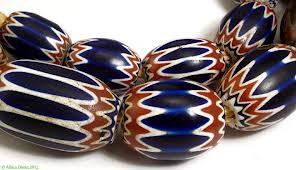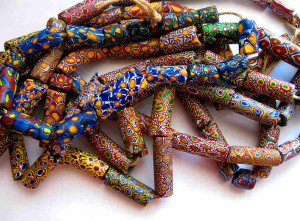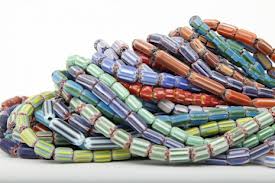 Trade beads date back to our ancient ancestors. The earliest known beads were made out of simple materials including bone, ivory, seeds, stone, wood and a variety of plant and insect resins. It’s believed that the first beads were worn as protection against uncontrollable events and the forces of nature, as well as to show one’s status in the community and to enhance beauty.
Trade beads date back to our ancient ancestors. The earliest known beads were made out of simple materials including bone, ivory, seeds, stone, wood and a variety of plant and insect resins. It’s believed that the first beads were worn as protection against uncontrollable events and the forces of nature, as well as to show one’s status in the community and to enhance beauty.
As bead making evolved, and trade routes were established, the use of beads for trade began. Trade beads are usually associated with West Africa where they are often found. However many of them were originally created in Venice, Bohemia, and Holland. Trade beads date back to the fifteenth century when Portuguese trading ships arrived on the coast of West Africa to exploit its many resources, including gold, slaves, ivory, and palm oil.
 In the late 1500s, beads were a major component of the currency exchanged for people, products and resources. Over the next four centuries, millions of beads were traded to Africa, and by the nineteenth century, European bead makers were producing a wide variety of designs for trade.
In the late 1500s, beads were a major component of the currency exchanged for people, products and resources. Over the next four centuries, millions of beads were traded to Africa, and by the nineteenth century, European bead makers were producing a wide variety of designs for trade.
Trade beads have become more popular in the West over the last few decades when Africa began supplying beads in large numbers and in a diverse array of colors, materials, and shapes. Bead enthusiasts around the world now readily collect trade beads. The beads are collected, rethreaded onto raffia strings and sold to importers in the United States and Europe. Once considered to have no real value, these beads are now highly desirable, with some of the rare varieties commanding substantial sums.
